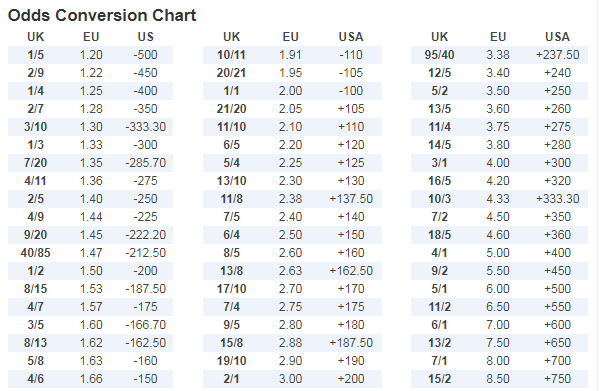Table Of Contents
What Is The Difference Between American Odds, Fractional Odds And Decimal Odds?
Last Updated on: November 16th, 2024
Did you know that, according to one UK-based bookmaker, there are 500/1 odds of Kanye West becoming the next US president? Depending on your viewpoint, it’s a brave or foolish bet or American odds.
But while political betting markets aren’t offered in the US, these odds wouldn’t read as 500/1 in American bookies. They’d instead read as +50000, while it would be presented as 501.00 in Australia.
That is to say, there is no single odds format used universally across the world. In this article, you will get to know the difference between Moneyline or American odds, fractional odds, and decimal odds.
What Is The Difference Between American Odds, Fractional Odds, And Decimal Odds?">What Is The Difference Between American Odds, Fractional Odds, And Decimal Odds?
Whether you’re trying your luck with seemingly absurd wagers, or gambling on more probable outcomes, you have to understand the betting odds used so you can always work out the best returns. Do you know about bet365 odds? Search on google and get some ideas.
The three main formats are American, fractional, and decimal odds and, as touched upon, different countries have different preferences. Let’s take a look at each format in turn.
American Odds (Moneyline)">American Odds (Moneyline)
American odds (also known as Moneyline or US odds) display the favorites with a minus sign and a number indicating how much you need to stake to win $100. The odds for the underdogs have a plus sign, showing the amount you’d win for every $100 staked.
For example, in this guide to NFL odds, the odds for a game between the Chiefs and Packers are:
Chiefs +3 (-110)
Packers -3 (+110)
Ignoring the -3 and +3 figures, for now, the odds of +110 for the Packers indicates a lower probability of them winning the game. As such, it’s in the bookmaker’s interest to offer longer odds, which are more tempting.
You’d win $110 for every $100 gambled on the Packers if they unexpectedly won, which would give you $210 including your original stake. If you bet on the Chiefs instead, you would need to wager $110 to take home $100, which would also win you $210, including your stake.
So you’ll have to gamble more to win less on the Chiefs, hence why they are favorites.
The +3 and -3 represent the point spread. This means, to win a bet on the Packers, they would need to win the game by more than three points. To win on the Chiefs, they would need to lose by two points or less (or win the game).
The point spread works as an equalizer so that betting on either team offers an almost even chance of winning, despite the clear disparity between the two teams.
Fractional Odds">Fractional Odds
Fractional odds are typically used by the UK and Irish bookmakers. These are usually written with a slash or a hyphen — for example, 7/1 or 7-1, pronounced as seven-to-one. These particular betting odds would mean that you win $7 for every $1 you wager.
According to one soccer bookmaker, the three favorites to win the 2022 World Cup have the following odds:
France: 11/2
Germany: 13/2
Argentina 11/1
With shorter odds than the other two teams, France is the current frontrunner. And while you’d make $11 for every $2 spent on France and $13 for every $2 on Germany, you’d win $11 for each $1 you wagered on Argentina to be champions.
So, say you bet $100, you’d make $550 profit on France [$100 x (11/2)], $650 on Germany [$100 x (13/2)], and $1100 on Argentina [$100 x (11/1)].
There are also reverse fractional odds, known as ‘odds-on’ prices. The bottom number of the fraction shows how many times your stake will be divided to calculate your winnings:
$1 stake divided by 2 = $0.50 winnings = odds of 1/2
$5 stake divided by 2 = $2.50 winnings = odds of 1/2
$10 stake divided by 2 = $
5 winnings = odds of 1/2
Decimal Odds">Decimal Odds
You can use the decimal odds through the bookmakers in Europe, Australia, New Zealand, and Canada. These are very easy to understand, and instantly allow you to distinguish between the favorites and underdogs.
With decimal odds, the number represents what you’d win for every $1 wagered, including your stake. To work out the potential return, simply multiply the stake by the decimal number.
For example, one Australian bookmaker offers the following odds on who will win the 2020 US presidential election:
Joe Biden: 2:00
Donald Trump: 2:00
Mike Pence: 34:00
So, if you were to put $100 on either Biden or Trump, your total return would be $200 ($100 x 2.00). As this figure includes the initial stake, your net profit is $100. Whereas, if you wagered $100 on Pence, you’d take home $3400 ($100 x 34.00), with a profit of $3300. In addition, you can also learn about the bet365 odds.
FAQs">FAQs
I have adapted the questions that people raise on the internet maximum time. I hope, this will be beneficial for you when you will implement them together. So, let’s discuss them now.
Q1. How do you convert American odds to decimal?
A. There has a specific formula that you will use to convert American odds to decimal. Put forward the formula, decimal odds=(American odds / 100) + 1. Place the numbers and clear your answer.
Q2.How are decimal odds calculated?
A. Just divide the fractions and add on. You have to add one that will represent your stake.
From this, it’s obvious that Biden and Trump are clear frontrunners to be the next US president, with Pence’s long betting odds showing how unlikely his chances of taking office are perceived to be.
It is important to note that American, fractional, and decimal odds are simply alternative ways of presenting the same information, meaning you can convert between them easily.
Read Also:















All Comments
บาคาร่า สล็อต
11th August, 2023
Pretty! This has been a really wonderful post. Many thanks for providing these details.